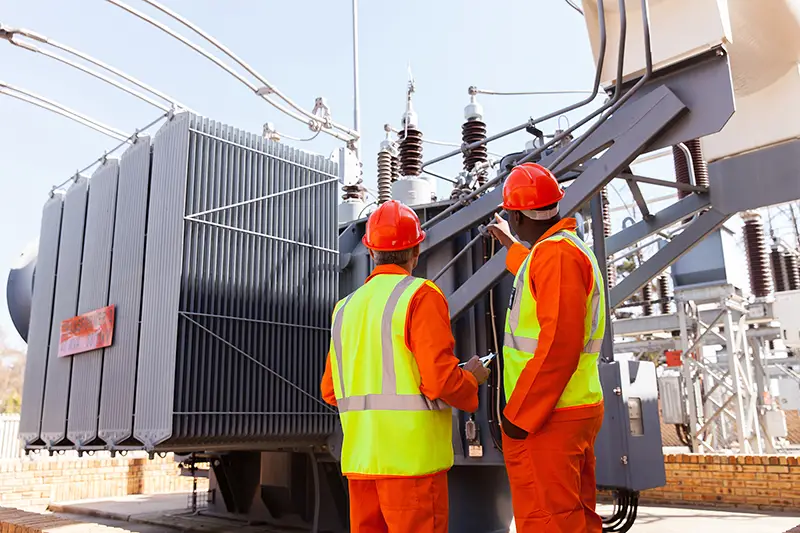Click here to get this post in PDF
This guide is the most comprehensive industrial transformer selection resource available. With advice on selecting a type of power transformer, providing suggestions for what size and voltage your transformers may need, and so much more, this guide will save you time on your industrial projects!
Why Do We Need an Industrial Transformer?
A transformer is a device that converts an alternating current (AC) into a direct current (DC) or vice versa. Transformers are used in a variety of industries, such as power generation, electricity distribution, and manufacturing. A transformer’s primary purpose is to change an AC power source’s frequency, voltage, and amperage.
There are a few reasons why you may need to purchase an industrial transformer:
If your business operates out of an AC-powered facility and needs to operate off of a single voltage source (e.g., 220V in the US), then you would need a transformer that can produce both 110V and 220V.
If your business operates out of both AC-powered and DC-powered facilities and needs to run multiple voltages simultaneously (i.e., 110V, 220V, and 480V in the US), then you will need two transformers: one for each voltage range.
If your business generates its own power from renewable resources such as solar panels or wind turbines, you might need an industrial transformer designed and manufactured by Meta Power Solutions to step down the voltage produced by these sources before it can be used by your business’ equipment.
What Kinds of Transformers to Consider?
When it comes to choosing the right industrial transformer, there are a few things to consider. Depending on your needs, you may want to choose between a step-up transformer, a linear transformer, and a switching transformer. Here’s a quick guide to help you choose the right industrial transformer for your needs.
Step-Up Transformers: These are good for applications that require more power than what a linear transformer can provide. They work by increasing voltage automatically as needed, so there’s no need to worry about priming or pumping.
Linear Transformers: These are great for applications that only need minimal voltage changes. They work by transforming direct current (DC) into alternating current (AC), which is the standard household electricity format.
Switching Transformers: These are perfect for applications that need to change voltage rapidly, such as in electronics or power generation. They work by switching between AC and DC voltages on-the-fly, allowing you to create the desired voltage quickly and easily.
Buying a New Industrial Transformer
Choosing the right industrial transformer for your project can be daunting. There are so many options, ratings, and specs to consider! This article will outline the key factors you should consider when choosing an industrial transformer and give you a comprehensive guide on what to look for when selecting one. Let’s get started!
When shopping for an industrial transformer, you need to keep a few key things in mind. Impacts like noise and efficiency are important considerations, but they are only part of the equation; your choice of the transformer also depends on the application it will be used in.
Noise Levels
Very high voltage transformers produce a lot of noise. If your application requires a high voltage level or your transformer is located close to other machinery or electronics, it is important to consider how much noise it will create. Check the manufacturers’ specs for the level of noise the transformer produces at various ratings. Bear in mind that higher ratings usually mean higher levels of noise.
Efficiency
Transformers convert electric energy into rotating mechanical energy. The more efficient your transformer, the more power it can handle before needing replacement or repair.
Filing a Power Loss Report
When a power loss occurs, filing a power loss report (PLR) as quickly as possible is important. By filing a PLR, you can preserve evidence of the event and possibly identify the cause of the outage.
To file a PLR, follow these steps:
1. Determine the time of the power loss. This information can be found on your breaker panel or on your municipality’s website.
2. Identify which circuit(s) experienced the power loss.
3. Contact your energy provider and provide them with the following information:
-Your name and address
-The date and time of the power loss
-The specific circuits that experienced the power loss
4. Take photographs or video of any damaged property or equipment as proof of the event that occurred.
Maintenance and Troubleshooting Tips for Industrial Transformers
There’s nothing quite as frustrating as a transformer that is constantly blowing its fuse, or completely shutting down during operations. With a little know-how and regular Maintenance and troubleshooting (M & T) tips, you can minimize the chances of these issues occurring.
1. Check for Safety first!
Before anything else, always make sure your industrial transformer is safe to operate. This means verifying that all connections are secure and checking for any signs of overheating or damaged insulation. If there are any concerns, do not hesitate to call your local electrician for help.
2. Conduct regular M&T
Once safety is confirmed, it’s time to get down to business with your M&T checks. A regular schedule will help identify problems early on and give you the chance to address them before they cause too much damage. Here are some things you should include:
Inspect all electrical connections—Make sure they are securely fastened and properly insulated. If corrosion is evident, replace the connection materials immediately.
You may also like: 5 Transformer Safety Best Practices For Industrial Professionals
Image source: Shutterstock.com

